The chemistry of flavour
We investigate the taste and aroma compounds of fermented foods that contribute to their flavour. We do this by measuring free amino acids, volatile compounds (by GC-MS), small metabolites (by NMR) and peptides that are products upon fermentation.
Amino acids and small peptides activate human taste receptors, and contribute to the distinct sensory properties that fermentation imparts on food organoleptic properties. They are important determinants of the sensory experience.

